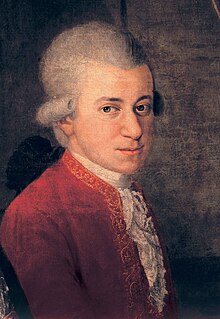 | Review waiting, please be patient.
This may take 6 weeks or more, since drafts are reviewed in no specific order. There are 1,183 pending submissions waiting for review.
Where to get help
How to improve a draft
You can also browse Wikipedia:Featured articles and Wikipedia:Good articles to find examples of Wikipedia's best writing on topics similar to your proposed article. Improving your odds of a speedy review To improve your odds of a faster review, tag your draft with relevant WikiProject tags using the button below. This will let reviewers know a new draft has been submitted in their area of interest. For instance, if you wrote about a female astronomer, you would want to add the Biography, Astronomy, and Women scientists tags. Editor resources
Reviewer tools
|

The Portraits of Wolfgang Amadeus Mozart are various paintings in which the classical composer Wolfgang Amadeus Mozart is portrayed. The posthumous 1819 painting by Barbara Krafft is the best known of all, but a large number of other types of representations exist. Some were made during Mozart's own lifetime, but most of them were realised after his death as Mozart became extremely popular. According to Robert Bory, sixty-two portraits of Mozart and pictorial representations of all kinds exist,[1] but they vary widely in size, technique used, style and the degree of fidelity shown of the model.
Several musicologists and Mozart experts, such as Arthur Hutchings, Arthur Schurig, Martin Braun and Alfred Einstein have examined these portraits, expressing various degrees of disappointment on the quality of the pictures, manifesting an opposition between the enormous amount of artworks that represent the genius and the scarce iconographic value of them.[2] Schurig stated in 1913 the following: "Mozart has been the famous composer of whom most fictitious portraits have been made, pictorial material that has contributed, not a little, to confuse later generations about his appearance".[3] For his part, Alfred Einstein expressed his opinion about these portraits in the following statement: "No earthly remains of Mozart survived save a few wretched portraits, no two of which are alike".[4]
These statements led musicologists and art historians to undertake a rigorous analysis of most existing paintings, miniatures, sketches, drawings, cameos and engravings of the composer. Julius Leisching[5] and Max Zenger[6] made a first selection and, finally, Otto Erich Deutsch established a list of the authentic portraits and the forgeries, mostly from the XIX century.[7] The conclusion of this was that only eight works of art,[8] all of them of unequal interest, were produced by authors who knew Mozart directly, or by sketches taken from drawings made from life. From this selection afterwards, Mozart's "biographical paintings" have been published with more care, generally following the criteria that emerged from this analysis.[9]

Thus, it seems appropriate to point out a list of authors, contemporaries of the composer, who signed loose portraits of Mozart:[14][15] Pompeo Girolamo Battoni, François Joseph Bosio, Breitkopf, Joseph Duplessis, Nicolò Grassi, Jean-Baptiste Greuze, Giambettino Cignaroli, Louis Carrogis Carmontelle, Johann Nepomuk della Croce, Dominicus van der Smissen, Martin Knoller, Dora Stock, and Pietro Antonio Lorenzoni, among others. The study of these portraits can be interesting since, although they are not faithful to the physical features of the composer, they provide important iconographic data, either on musical instruments, or on other personalities that appear in them.[16]
Beyond the small number of authenticated portraits, we find a broad quantity of dubious and outright inauthentic paintings that supposedly represent Mozart. We find three types in the latter category; first are the portraits (most often young male musicians) of other people, which are claimed later on to be Mozart. Second are the fabricated forgeries of various kinds (created to either earn money or gain notoriety) in which the model is claimed to represent Mozart. And the third category is formed by fantastical paintings, produced by the artist's pure imagination with no basis in Mozart's actual extant iconography. These are usually inspired by common myths and legends about Mozart, crossing the line from art to kitsch.[17]
- ^ Bory, Robert (1948). La vie et l'oeuvre de Wolfgang-Amadeus Mozart par l'image. Suiza: Horizons de France
- ^ Hutchings, Arthur (1976). Mozart: The Man, the Musician. Thames and Hudson, pp. 4-5
- ^ Schuring, Arthur (1913). Wolfgang Amadeus Mozart. Sein Leben und sein Werk. Vol. 2. Insel Verlag
- ^ Einstein, Alfred (1962). Mozart, His Character, His Work. Oxford University Press, p. 471
- ^ Leisching, Julius (1926). Wolfgang A. Mozarts Bildnisse.
- ^ Zenger, Max (1941). Falsche Mozartbildnisse. Neues Mozart-Jahrbuch
- ^ Erich Deutsch, Otto (1961). Mozart and his World in Contemporary Pictures. Bärenreiter
- ^ Hutchings, Arthur (1976). Mozart: The Man, the Musician. Thames and Hudson, p. 5
- ^ Hutchings, Arthur (1976). Mozart: The Man, the Musician. Thames and Hudson, p. 5
- ^ Andrés, Ramón (2006). Mozart: Su Vida y su Obra. Swing, p. 56
- ^ Hutchings, Arthur (1976). Mozart: The Man, the Musician. Thames and Hudson, p. 6
- ^ Novello, Vincent and Mary (1955). A Mozart Pilgrimage: Being the Travel Diaries of Vincent & Mary Novello in the Year 1829. Novello Editions
- ^ Landon, Robbins (2005). 1791: El último año de Mozart. Siruela, p. 72
- ^ Zenger, Max (1941). Falsche Mozartbildnisse. Neues Mozart-Jahrbuch
- ^ Hutchings, Arthur (1976). Mozart: The Man, the Musician. Thames and Hudson, p. 5
- ^ Hutchings, Arthur (1976). Mozart: The Man, the Musician. Thames and Hudson, p. 5
- ^ Cornell University: Mozart's Images Imagined